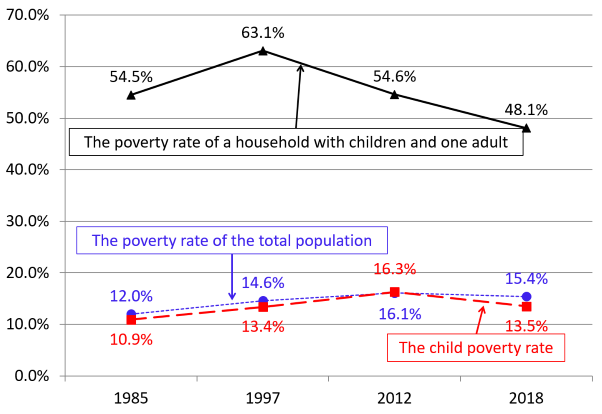Column Finance and the Social Security System 2020.08.17
【Aging, safety net and fiscal crisis in Japan】No.261: The child poverty rate remains high
In this column series, Yukihiro Matsuyama, Research Director at CIGS introduces the latest information about aging, safety net and fiscal crisis in Japan with data of international comparison.
On July 17th, 2020, the Ministry of Health, Labor and Welfare released survey data on the child poverty rate in 2018. The poverty rate is a figure that shows the percentage of people living below the poverty line income, which is defined as half of the median of the entire population’s equivalent disposable income. The equivalent disposable income is a concept that adjusts for the effect of the number of family members on their disposable income, and is calculated by dividing their income by the square root of the number of family members.
As shown in Figure 1, Japan’s equivalent disposable income peaked at JPY 2,970,000 (US$ 27,500) in 1997 and then fell to JPY 2,530,000 (US$ 23,400) in 2018. Its poverty line income also fell from JPY 1,490,000 (US$ 13,750) to JPY 1,270,000 (US$ 11,700) during the same period.
The poverty rate of the entire Japanese population rose from 12.0% in 1985 to 16.1% in 2012, and then declined to 15.4% in 2018 (Figure 2). The child poverty rate, including children aged 0 to 17, also dropped from 16.3% in 2012 to 13.5% in 2018, giving the impression that income disparity has narrowed. However, Japan’s poverty rate is classified as high among OECD countries. According to OECD data on the child poverty rate of each country, Japan’s rate (13.5%) is lower than that of the United States (21.2%), but higher than that of the United Kingdom (12.4%), Canada (11.6%), Germany (11.3%), France (11.2%), the Netherlands (10.9%), and Sweden (9.0%). In particular, the poverty rate of single-parent households was 48.1% in 2018, which cannot be overlooked. For this reason, the government decided to introduce the “Outline on measures against child poverty” in November 2019, although the outcome of the policy is not yet visible.
Figure 1: The median household income of the total population and the poverty line

Source: Ministry of Health, Labor and Welfare
Figure 2: Poverty rates

Source: Ministry of Health, Labor and Welfare
